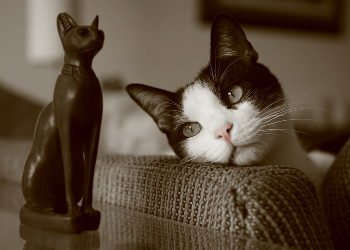Diseases #28

The pleura is the membranous lining of the chest cavity. A pleural effucsion is an excessive production or accumulation of free fluid in the thoracic space outside of the lungs. Fluids can be made up of 4 main types causing disease:
1. Pyothorax: Accumulation of pus in the thorax
2. Chylothorax: Accumulation of lymph fluid in the thorax.
3. Hemothorax: Accumulation of blood in the thorax.
4. Non-Transudate Pleural Effusion: Accumulation of a non-infectious serum in pleural spaces.
Causes of pleural effusions can be due to: trauma to the chest, heartworm disease in dogs, low serum protein levels, rupture of the thoracic duct, bacterial, liver disease, twisting of a lung lobe amongst others.
The most common type of pleural effusion in cats is chylothorax. It is seen commonly in practice. The second common type seen is pyothorax.
.
The accumulation of fluid in the chest is a medical emergency. Buildup of any type of fluid in the chest increases the pressure on the lungs. The chest is a closed cavity. Fluid has no where to go hence the lungs get compressed making it extremely difficult to breathe or move around without becoming cyanotic. If the process is infectious, bacteria will become absorbed and can cause a septic infection.
Clinical signs most commonly seen are: extreme difficulty breathing, open mouth breathing, cyanosis, increased abdominal breathing, anxiety, anorexia and coughing.
A CBC and Chemistry and urinalysis are always performed to assess the white cell count, protein and electrolyte levels and organ function. Thoracocentesis (draining fluid from the chest) is often diagnostic and therapeutic at the same time. Identification of the cell type and consistency of the fluid will often provide crucial information.
Extreme caution is in order when deciding to position a cat for radiographic films. Better to drain as much fluid from the chest before taking films. Not only will the thoracic contents be easier to view but it is also safer for the cat. Cats in respiratory distress can crash or turn blue just by positioning the animal for radiographs. Go real slow! The same goes with positioning for an ultrasound.
Diagnosis of pleural effusions is made by a history and complete physical exam; including thoracocentesis. Combined with laboratory findings a diagnosis is made.
Treatment is geared at treating the primary cause of pleural effusion. Tapping and withdrawing as much fluid from both sides of the chest is imperative. This will make it much easier for the cat or dog to breathe. Culture results from a pyothorax will provide information for the most effective antibiotics to use. Chest drains are also put in allowing fluid to be tapped at regular intervals. The most common type of pleural effusion in cats is chylothorax. The cause is the rupturing or tearing (trauma) of the thoracic duct that empties into the cranial vena cava. During surgery, the thoracic duct is repaired with ligatures. Animals are administered oxygen and other supportive treatment as deemed warranted by the veterinarian.
The prognosis for pleural effusion is guarded until the outcome of the condition is known. That is: a decrease in the production of fluid, an animal that starts eating and drinking on its own and successful treatment of the primary cause.



Pyelonephritis is an inflammation of the renal pelvis in the kidneys. The renal pelvis is the funnel shaped tube that is the proximal start of the ureter that carries urine from the kidneys to the urinary bladder. Anything that can stop the flow of urine or its production can lead to the disease. Common causes are: decreased blood flow to the organ, calculus (stones) blocking a ureter or renal pelvis, an ascending bacterial urinary tract infection or severe sepsis.
The presence of bacteria associated with pyelonephritis are often those same types that cause infection in the urinary bladder. Pseudomonas sp, Escherichia coli, Enterobacter sp are all seen in cultures of renal infection. Inflammation of the renal pelvis will cause malfunctions in the formation of urine and its ability to concentrate it. This is due to the altered architecture of the organ. That architecture is known as the nephron. This condition is seen in the young, old and immuno-compromised animals. Animals with glomerulonephritis may also develop this due to the clogging of the glomerulous with antigen/antibody combinations. Pyelonephritis causes a lot of pain in the animal.
The most common clinical signs are: pain while urinating, blood in the urine, foul smelling urine, increase in thirst, increase in urination frequency plus lower lumbar pain. Dogs or cats may also run a fever due to a neutrophilic leukocytosis.
Animals should undergo a CBC and Chemistry Profile. It is crucial that a urine sample be collected for a urinalysis and one obtained by cystocentesis (urine collected by going directly into the urinary bladder through the abdominal wall) for culture and sensitivity. Radiographs and ultrasounds are important in studying the renal architecture. Pyelocentesis is the aspiration of fluids from the renal pelvis. This is always done by a needle that is guided by ultrasound. This material is than cultured and an appropriate antibiotic is found to treat the infection.
Diagnosis is made from historical findings, lab work and a physical exam. A prior history of a urinary tract infection may provide clues. This is a very common occurence prior to pyelonephritis.
Treatment of pyelonephritis, or even if it is suggested, should start immediately to protect renal function. Renal function is supported by increasing blood flow via an intravenous line and fluid administration. The primary cause has to be dealt with. Removal of calculus or other obstructions is necessary. Intravenous antibiotics are provided for a long period and followed up with oral antibiotics that are taken until the renal infection halts and renal function returns to normal with a clear urine.
Many cases of pyelonephritis resolve with aggressive medical and or surgical care. Any obstruction has to be relieved. Blood flow to the kidneys has to be restored. The primary cause has to be dealt with. Until those are resolved, a guarded prognosis is warranted. Once discharged, animals have to be examined plus repeat ultrasounds and urine exams have to be performed.



Pyoderma is a common skin infection seen in dogs and cats due to the presence of abnormal bacteria. Many pyodermas are secondary to other conditions such as: flea infestation, thyroid deficiency, autoimmune diseases, cutaneous lymphosarcoma, trauma to the skin amongst others.
Young animals often develop a pyoderma known as "puppy pyoderma". It is seen most frequently in sexually immature male or female animals; usually dogs. Pustules are commonly seen in the vaginal area of the female or prepucial area of the male. Most will spontaneously clear as the animal matures. Some may require oral antibiotics, such as Clavamox®, to clear them.
The skin is the largest organ in the body. It serves as a protective shell from exogenous threats or dangers. One of the biggest threats to the skin is bacteria. The skin is said to be healthy when it serves as a protective barrier to keep bacteria out of the body. When that integrity is broken, bacterial can set up shop in the skin and cause the clinical signs seen with the disease.
Clinical signs seen with pyoderma are: the production of inflamed scaly skin, pustules, a rash, loss of hair and itchy skin. It is this itchy skin that causes the most damage. Dogs do not wear shoes! Their paws carry coliform bacteria. Bacteria is introduced into the wound when scratching. In fact, it is this self mutilation that worsens all clinical signs and makes the infection even worse in dogs and cats. The itch has to stop! Cats will also lick at themselves continously and produce an excess of hairballs.
The first order of business is always a skin scraping to rule out parasitic involvement. Skin cultures may often be taken to figure out the type of bacteria that is causing the infection plus the most effective antibiotic to treat it. Other lab work must be performed to diagnose the primary condition. If the thyroid is suspect in causing the pyoderma, checking the levels of T4 and FT4 are important. A CBC is important to check the levels of white cells such as neutrophils (in infection) and eosinophils (in allergy). Biopsies may be taken for a cellular diagnosis.
Diagnosis of pyoderma is made by historical findings and a complete physical exam. Laboratory work will confirm the diagnosis. Pyoderma must be differentiated from autoimmune diseases such as Pemphigus Complex and neoplasias such as cutaneous lymphosarcoma. This is accomplished by the results of the skin biopsy or staining of it or by employing fluorescent antibody tests on the specimen.
The most important treatment is treating the primary cause of the pyoderma. Pyodermas, regardless of the cause, require long term antibiotic therapy; often for months at a time. If antibiotics are not provided for the appropriate amount of time, resistance will occur with a high possibility of developing a deep pyoderma which can be extremely difficult to treat.
Shampooing is crucial to rid the skin of debris, cells and other components that make it harder for the skin to "breathe". A medical shampoo that contains chlorhexidine and or ketoconazole are worth their weight in gold in helping to control and treat pyodermas. The rule of thumb in using shampoos is to shampoo the animal twice a week for two weeks, than once weekly forever! Do not use hot or even warm water to bathe the animal. That will drive the dog or cat crazy. Use cool water. It is soothing to the animal and also temporarily numbs the skin; indirectly making the animal feel better.
The prognosis for most pyodermas is very good if medical care is sought before it becomes chronic. Treatment of the underlying cause is of the greatest importance when thinking of a favorable long term prognosis.



Pyometra is a severe gynecological disease of middle aged to older female dogs and cats. It is one of the most common gynecological disorders seen in the dog. The cause of pyometra is due mainly to hormonal inbalances, particularly progesterone, and a thickening of the uterine wall over time.
As a female ages, the uterus often thickens. This is known as uterine hyperplasia. This creates many deep grooves that are perfect sites for bacteria to hide. The bacteria can easily creep up through a dilated cervical opening. With associated hormone imbalances a severe, purulent infection begins. In time, the uterine horns are nothing more than a huge abdominal abscess! This infection can be life threatening if the dog or cat is not immediately spayed. Clinical signs present due to this infection plus whether the pyometra is closed or open.
Clinical signs occur in unaltered, middle aged female dogs or cats. Classical signs are: an increase in thirst, fever, lethargy, collapse and anorexia. In an open pyometra, there will be a foul smelling, purulent vaginal discharge. The closed version is a bit more difficult to figure out (in the short term) since the cervix is closed hence not allowing any drainage through the vagina to the outside. Since there isn't any vaginal drainage, the abdomen will appear distended. These animals often are extremely ill since there has been no elimination of pus and bacteria. Toxin production by the bacteria can cause renal shutdown in those situations.
A CBC and Chemistry profile are crucial. The white cell count in most animals is over 40,000 with some of them reaching 75,000! Chemistries may show an elevated BUN or Creatinine secondary to dehydration or bacterial toxin overload. Staining of the vaginal smear will identify many bacteria and pus cells. Culturing that discharge will identify the bacteria and the best antibiotics to use in the treatment. Radiographs or an ultrasound will show an enlarged uterus.
Diagnosis is achieved by historical findings of an unaltered female dog or cat that was recently in estrous. Clinical signs, vaginal discharge (in open cases) plus other laboratory data will confirm the diagnosis.
The treatment of choice is an emergency ovariohysterectomy (spay). This is by no means a "routine" spay. It is managed in a totally different way. The animal has to be prepped first with intravenous fluids and antibiotics before surgery commences to insure renal function and immediate antibacterial activity. The uterine horns are generally 10-50 times their normal size so care has to be taken that the organ is raised carefully above the abdominal incision so as to prevent horns from rupturing their contents into the abdomen. That has never happened in my career. Extreme care is the way to go. Animals are hospitalized and routine CBC's are taken once or twice a day. Antibiotics are prescribed and owners are instructed to clean the vaginal area with warm, soapy water for hygiene.
Closed pyometras may actually rupture. This is not good. The animal is spayed but you have to deal with the upcoming peritonitis that can cause massive medical issues. In those cases, the abdominal contents are lavaged with warm saline and antibiotics are put into the abdominal cavity. Drains may be put in to flush the abdomen once it is surgically closed. Those cases can be dicey.
The prognosis for most pyometra dogs is very good once aggressive medical and surgical care is sought. Animals with impaired renal function are guarded and will improve once renal function returns with fluid and antibiotic therapy.
There are cases where an owner may want to still breed a dog. There is a non-medical treatment of pyometra employing prostaglandin drugs. This also can be dicey. It may initially treat a pyometra allowing the uterine material to drain but there is a huge chance of recurrence. It is also less likely to work if the dog or cat has a closed pyometra. Animals that are septic and or in renal failure do not have time for prostaglandins to work and those animals require an immediate spay.
Pyometra



Rabies is an extremely dangerous world wide disease that can afflict any mammal; not just man and his companion animals. There has not been ONE human in mankind's history that has survived a clinical case of rabies! Rabies is a virus and caused by a rhabdovirus and always causes neurological signs. It actually looks like a bullet!
Animals that carry rabies have a tremendous amount of it in their saliva. The most common way the virus is transmitted to any mammal is by the bite of an infected animal. The closer the bite to the central nervous system, the sooner clinical signs will develop. Scratches and coming into contact with infected saliva that touches any exposed cut or mucous membrane may also produce clinical signs. The most dangerous component of rabies is the carrier of the disease in the wild. The most common carriers of rabies in the wild are: skunks, raccoons, foxes and bats. Be careful if you see a raccoon stumbling around during the day time. They are nocturnal animals so seeing them during the day is abnormal. The ataxia in the raccoon is often caused by Canine Distemper virus. DO NOT ASSUME THIS. It also may be rabid, so stay away! In the United States, rabies is more common in the southern states such as: Florida, Texas and California. Cats develop clinical rabies much more often than dogs. The reason for this is that the cats normal nocturnal habits make it come in contact with other nocturnal animals that carry the virus. I have always preached to the choir asking clients to keep their cats indoors. It eliminates that exposure. They will respond and say...."Oh, my cat is vaccinated". No vaccine is perfect and do you really want to have that vaccine challenged? Remember that vaccination of dogs and cats not only protects the animals but protects human life!!
The most common signs of rabies in pets are behavioral changes. A docile animal may become more aggressive. The animal becomes a totally different creature. Animals become hyperesthetic. That means extremely sensitive to any stimuli such as touch or noise. They will often try to bite at people. In later stages the classical foaming at the mouth occurs with associated seizures, paralysis, ataxia and acute death.
Brain tissue is stained and analyzed looking for the characteristic formation of Negri Bodies in the brain tissue.
A diagnosis of rabies can be suspect in an unvaccinated animal demonstrating clinical signs of rabies. The management and handling of these animals for euthanasia is extremely dangerous. I should know that. I have been in those situations. Care is of the utmost that personnel do not get bit! The diagnosis is confirmed by finding Negri Bodies in the brain tissue.
Clinical rabies is always fatal. No mammal has ever survived clinical rabies. There is no treatment.
Horrible prognosis. The best defense is vaccination of all pets. Each state has its own laws regulating vaccination. This is an excellent PDF document provided by the AVMA.
Each state handles an animal bite in various ways. In general, if a vaccinated animal bites a person or another animal, the pet is quarantined at the owner's residence for 10 days. If the animal is not vaccinated for rabies, it is quarantined at a licensed veterinarian's facility for 10 days at the owner's expense. Please call your local veterinarian or board of health for your local laws.
Vaccination is crucial for domestic pets and this includes dogs, cats and ferrets. The minimal age to receive a rabies vaccination is 12 weeks of age. Once the first vaccine is administered the veterinarian will booster it in a year to achieve the anamnestic response. This is also known as the booster effect. The second dose of a vaccine exponentially elevates the levels of antibodies to a disease agent. Whether a veterinarian offers a one year or three year vaccine is up to that individual. The key is common sense. In my Ohio practice after an initial rabies vaccination, I gave a 3 year vaccine to dogs yet in cats signed the certificate for only one year. Rabies is more common in cats and I wanted to insure that each cat got the maximum boost effect. In Florida, most practitioners (including myself) sign rabies certificates for one year in dogs or cats after an initial rabies vaccination.

